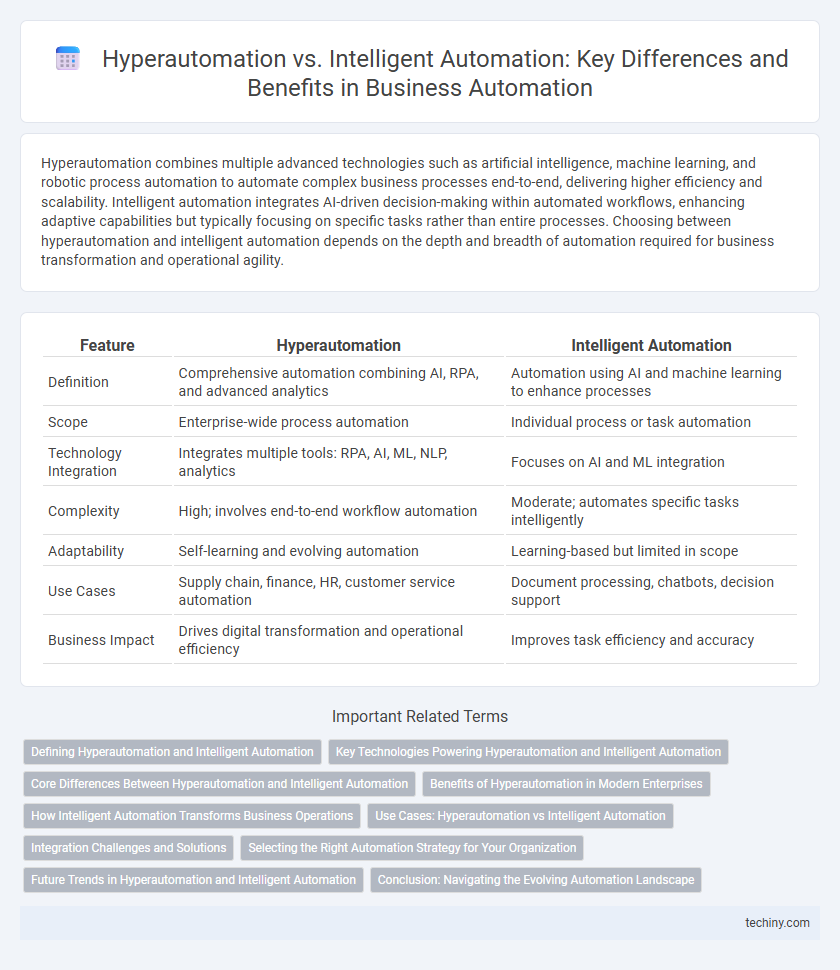Hyperautomation combines multiple advanced technologies such as artificial intelligence, machine learning, and robotic process automation to automate complex business processes end-to-end, delivering higher efficiency and scalability. Intelligent automation integrates AI-driven decision-making within automated workflows, enhancing adaptive capabilities but typically focusing on specific tasks rather than entire processes. Choosing between hyperautomation and intelligent automation depends on the depth and breadth of automation required for business transformation and operational agility.
Table of Comparison
| Feature | Hyperautomation | Intelligent Automation |
|---|---|---|
| Definition | Comprehensive automation combining AI, RPA, and advanced analytics | Automation using AI and machine learning to enhance processes |
| Scope | Enterprise-wide process automation | Individual process or task automation |
| Technology Integration | Integrates multiple tools: RPA, AI, ML, NLP, analytics | Focuses on AI and ML integration |
| Complexity | High; involves end-to-end workflow automation | Moderate; automates specific tasks intelligently |
| Adaptability | Self-learning and evolving automation | Learning-based but limited in scope |
| Use Cases | Supply chain, finance, HR, customer service automation | Document processing, chatbots, decision support |
| Business Impact | Drives digital transformation and operational efficiency | Improves task efficiency and accuracy |
Defining Hyperautomation and Intelligent Automation
Hyperautomation combines advanced technologies such as artificial intelligence (AI), machine learning (ML), robotic process automation (RPA), and process mining to automate complex business processes end-to-end. Intelligent automation integrates AI and ML with traditional automation tools to enable decision-making capabilities and adapt to changing conditions while executing repetitive tasks. Hyperautomation extends the scope of intelligent automation by orchestrating multiple automation tools and technologies across the enterprise for comprehensive digital transformation.
Key Technologies Powering Hyperautomation and Intelligent Automation
Robotic Process Automation (RPA), Artificial Intelligence (AI), and Machine Learning (ML) form the core technologies driving both hyperautomation and intelligent automation, enabling businesses to automate complex workflows beyond simple repetitive tasks. Hyperautomation integrates advanced analytics, process mining, and decision management tools to enhance automation scalability and adaptability, while intelligent automation focuses on contextual AI and natural language processing to improve process intelligence. Cloud computing and API integrations further empower these automation frameworks, facilitating seamless data flow and real-time analytics essential for dynamic business environments.
Core Differences Between Hyperautomation and Intelligent Automation
Hyperautomation integrates multiple automation technologies, including AI, machine learning, and robotic process automation (RPA), to automate complex business processes end-to-end. Intelligent Automation primarily combines RPA with artificial intelligence to handle decision-based tasks, focusing on automating specific activities rather than entire workflows. The core difference lies in hyperautomation's broader scope and capability to orchestrate and continuously optimize interconnected automation tools, whereas intelligent automation targets smart task execution within defined boundaries.
Benefits of Hyperautomation in Modern Enterprises
Hyperautomation leverages advanced technologies like AI, machine learning, and robotic process automation (RPA) to streamline complex business processes more effectively than Intelligent Automation. It enables modern enterprises to achieve greater operational efficiency, reduce human error, and enhance scalability by automating end-to-end workflows. The comprehensive integration capabilities of Hyperautomation drive faster decision-making and improved customer experiences, positioning organizations for competitive advantage in dynamic markets.
How Intelligent Automation Transforms Business Operations
Intelligent Automation leverages artificial intelligence, machine learning, and robotic process automation to streamline complex business processes, enhancing accuracy and efficiency. By automating decision-making tasks and integrating cognitive capabilities, it enables businesses to respond dynamically to real-time data and customer needs. This transformation reduces operational costs, accelerates workflows, and empowers employees to focus on strategic activities that drive innovation and growth.
Use Cases: Hyperautomation vs Intelligent Automation
Hyperautomation integrates multiple automation technologies such as AI, RPA, and machine learning to automate complex end-to-end business processes, ideal for large-scale enterprise workflows like supply chain management and customer service optimization. Intelligent Automation leverages AI-driven capabilities within robotic process automation to enhance specific tasks, making it suitable for use cases like invoice processing, data extraction, and repetitive administrative tasks. Enterprises choose Hyperautomation for comprehensive transformation across interconnected systems, while Intelligent Automation targets efficiency gains in isolated processes.
Integration Challenges and Solutions
Hyperautomation faces integration challenges due to the complexity of combining multiple advanced technologies like AI, RPA, and machine learning across diverse enterprise systems. Intelligent automation simplifies integration by focusing on specific tasks using AI-driven tools that seamlessly connect with existing workflows, reducing compatibility issues. Solutions to these challenges include adopting standardized APIs, utilizing middleware platforms, and implementing scalable architecture to ensure smooth interoperability between systems.
Selecting the Right Automation Strategy for Your Organization
Hyperautomation leverages a combination of advanced technologies such as AI, machine learning, and robotic process automation (RPA) to automate complex business processes end-to-end, offering scalability and comprehensive insights. Intelligent Automation integrates AI-driven decision-making with RPA to optimize specific tasks, enhancing efficiency and accuracy within targeted workflows. Selecting the right automation strategy depends on organizational goals, process complexity, and readiness for digital transformation, with hyperautomation suited for large-scale transformation and intelligent automation ideal for incremental efficiency gains.
Future Trends in Hyperautomation and Intelligent Automation
Future trends in hyperautomation emphasize advanced AI integration, enabling end-to-end process automation with real-time analytics and decision-making capabilities. Intelligent automation is evolving to incorporate machine learning models that enhance adaptability and predictive insights across industries. Both technologies are converging to drive efficiency, scalability, and innovation in enterprise workflows, leveraging robotic process automation (RPA), natural language processing (NLP), and AI-driven cognitive services.
Conclusion: Navigating the Evolving Automation Landscape
Hyperautomation encompasses a broader scope by integrating multiple advanced technologies, including AI, RPA, and machine learning, to automate complex business processes end-to-end. Intelligent Automation primarily focuses on combining RPA with AI capabilities to enhance specific tasks, improving efficiency and accuracy within defined workflows. Organizations embracing hyperautomation gain a strategic advantage through scalable, adaptive solutions that drive digital transformation and operational excellence across diverse industries.
Hyperautomation vs Intelligent Automation Infographic

 techiny.com
techiny.com